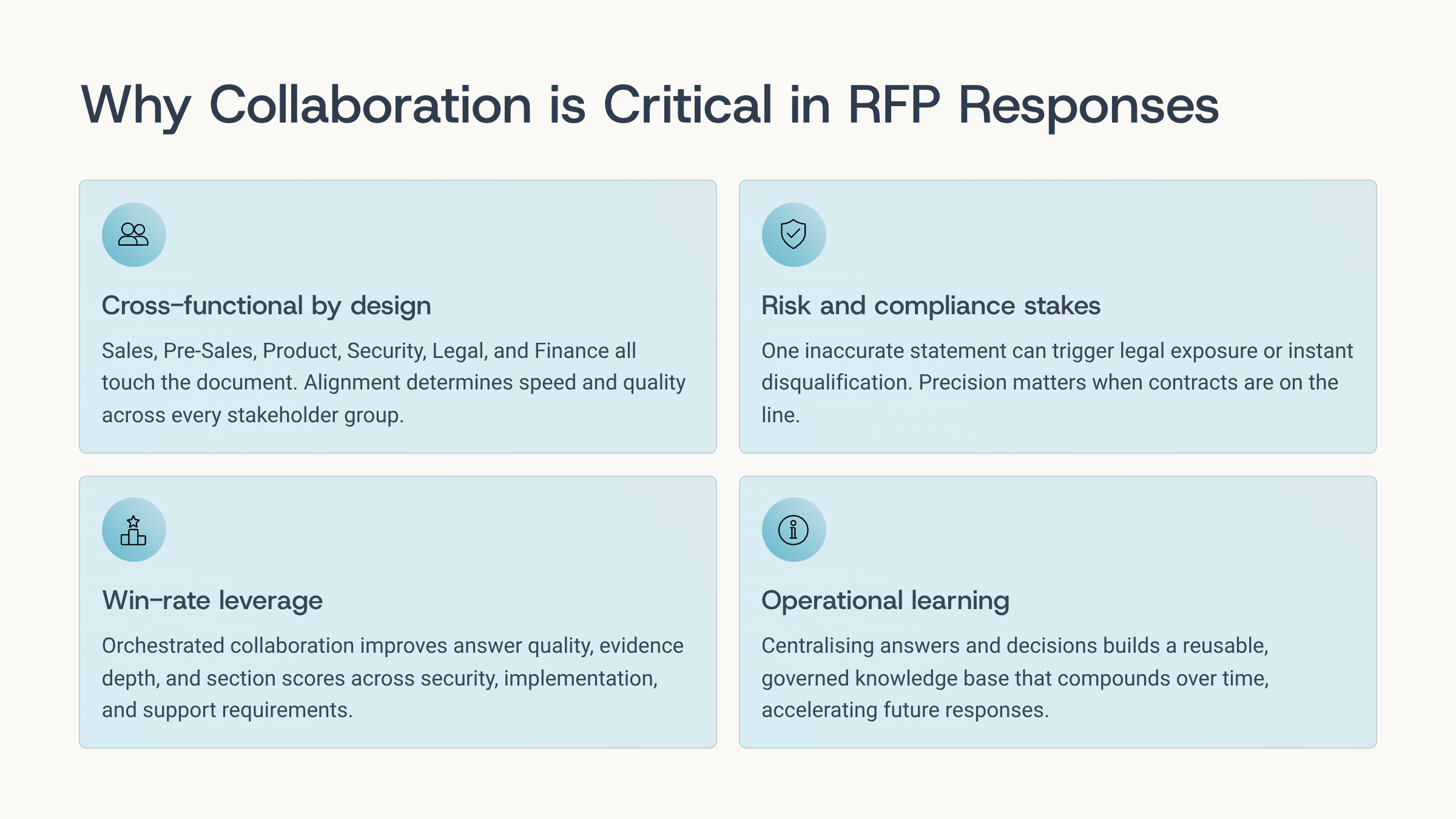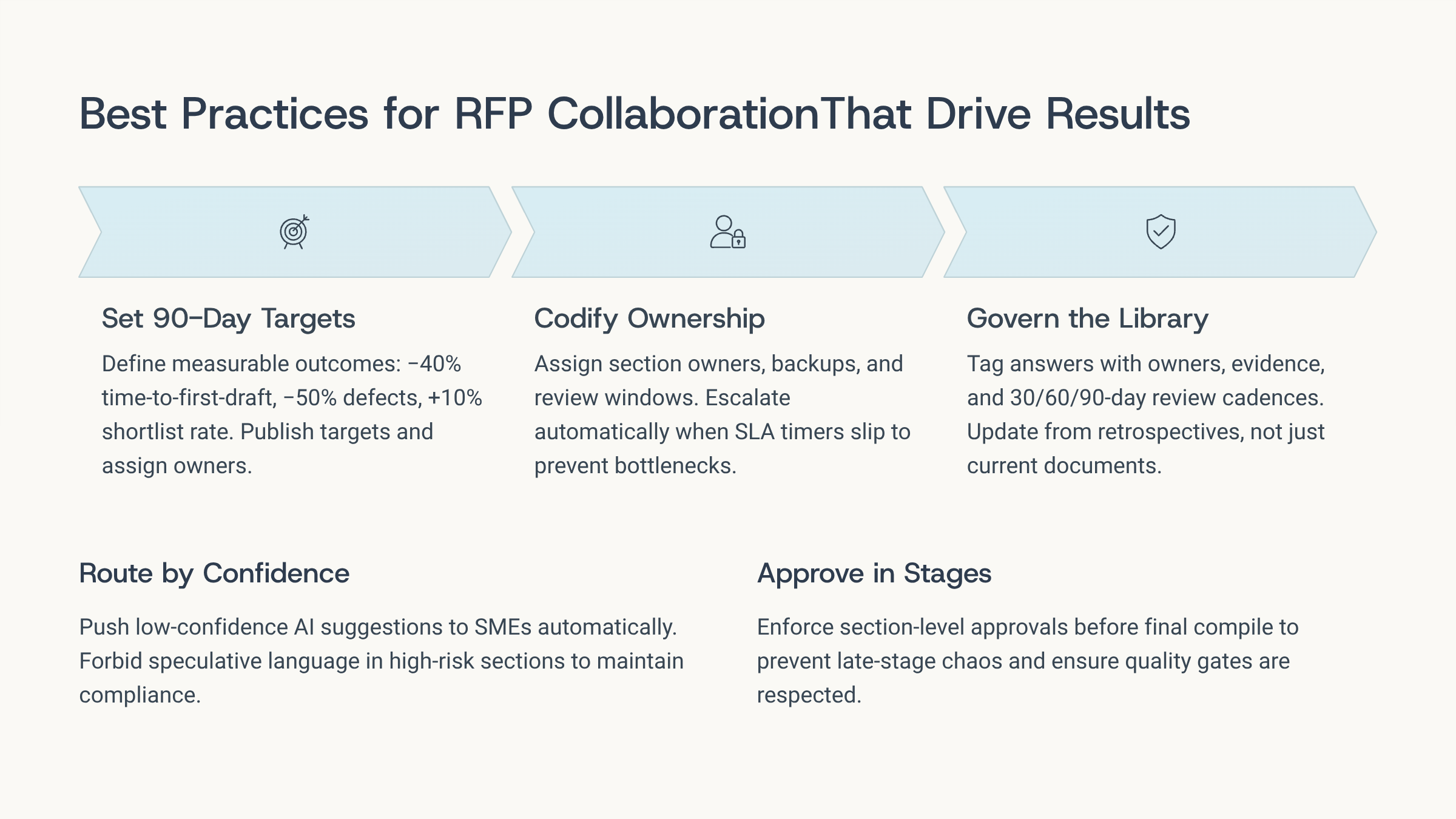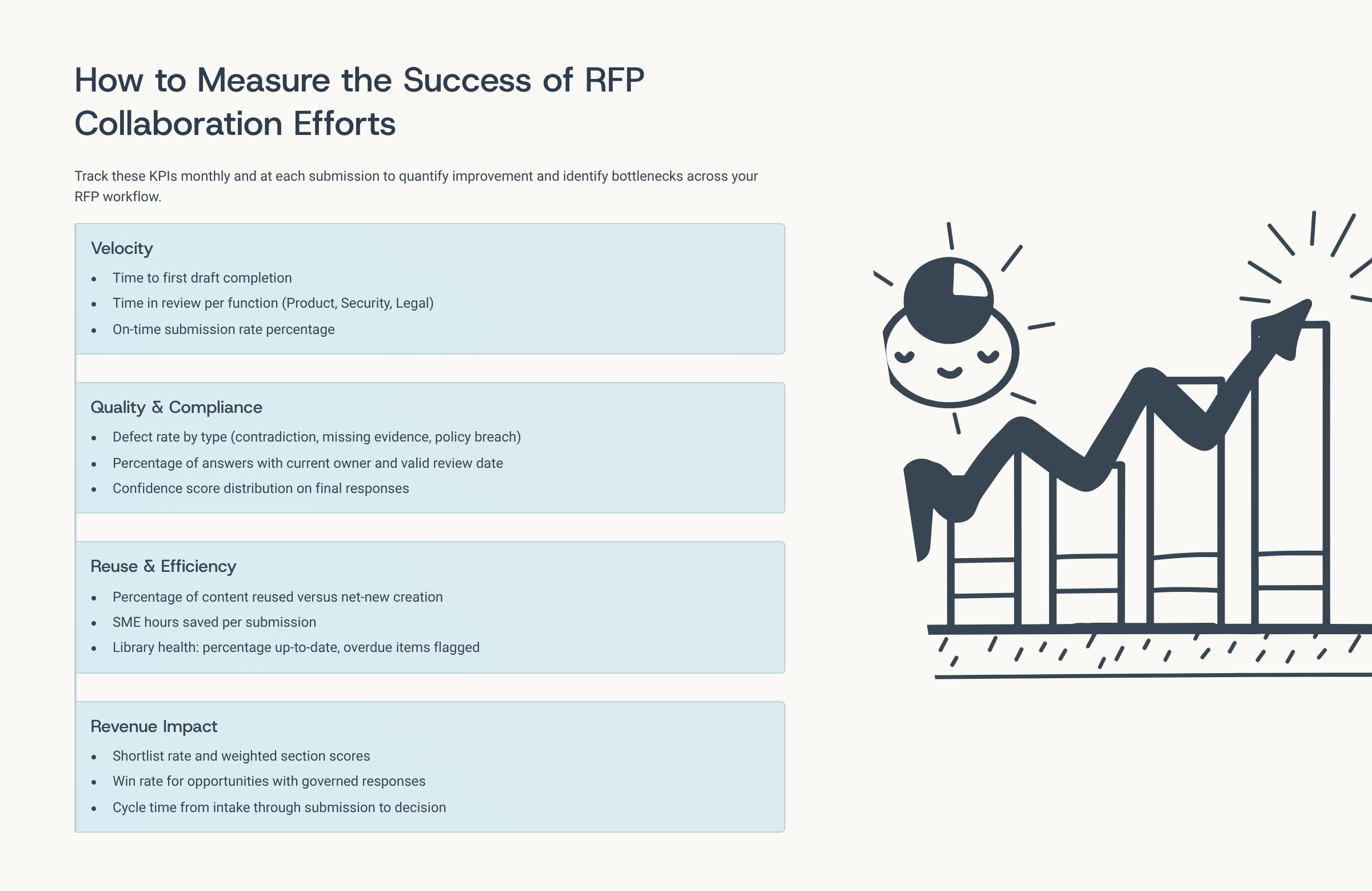Collaboration Platform for RFPs: Because Email Tennis Is Not a Team Sport
Article written by
Kate Williams

INSIDE THE ARTICLE
SHARE THIS ARTICLE
Summary
Most teams manage RFPs through email chains and version chaos, creating coordination nightmares that lose deals. Email tennis with 150+ messages, multiple conflicting versions, and deadline scrambles makes teams look unprofessional. Modern RFP collaboration platforms enable real-time teamwork, cutting response time 60% and boosting win rates 35% through seamless coordination.
If your RFP workflow still survives on reply-all threads, rogue folders, and a dozen files, you’re paying a hidden tax in time, risk, and win rate. RFPs are multidisciplinary by nature—architecture, privacy, pricing, SLAs, and legal terms—so the quality of your response reflects the quality of your collaboration. The moment you replace scattered effort with a governed, AI-assisted system of action, velocity and confidence move together.
That shift starts by understanding why collaboration is the difference between heroic one-offs and repeatable wins—then designing for it, not just hoping for it.
Why Collaboration is Critical in RFP Responses
Great RFPs read like one mind wrote them. Behind that illusion sits well-orchestrated RFP collaboration software that coordinates Sales, Pre-Sales, Product, Security, Legal, and Finance. Collaboration is critical because answers must be accurate, current, consistent with your public claims, and defensible with evidence. When owners are clear and workflows are visible, you compress cycle time without inviting compliance risk.
Effective collaboration also compounds over time. A shared knowledge base turns “custom writing” into “curated assembly,” while approval gates protect brand and legal posture. The end result—faster submissions, fewer defects, and stronger scores on weighted sections—creates a measurable path to higher shortlist and win rates. Knowing why it matters makes the next question unavoidable: what keeps teams from doing this already?
To build the right solution, you need to name the friction you’re removing, not just the features you’re adding.

Challenges in Traditional RFP Collaboration
Email was never designed to run complex projects. In traditional RFP collaboration, answers scatter into inboxes and personal drives, creating duplicates and contradictions. Ownership blurs, so “everyone is responsible” becomes “no one is available.” Parallel edits spawn version drift, and Security/Legal often arrive late—triggering rework and missed deadlines. Worse, there’s no auditable chain of approvals, which undermines governance and trust.
These problems aren’t just annoying—they’re expensive. Every defect invites scrutiny, every delay erodes credibility, and every missing citation becomes a risk for Legal and InfoSec. When the pain is named, the pattern is clear: you don’t need another shared folder; you need a collaboration platform for RFPs that governs answers, routes work with SLAs, and proves who approved what and when.
Once the gaps are visible, it’s time to define the system built to close them—end to end.
What is an RFP collaboration platform?
An RFP collaboration platform is a centralized, secure workspace that unifies intake, drafting, reviews, approvals, and export for RFPs, RFIs, RFQs, DDQs, and security questionnaires. It layers a governed answer library, role-based workflows, and AI-grounded drafting over your CRM and document stores. Instead of ad-hoc writing, teams assemble responses from verified knowledge, attach evidence, and move through gated approvals with full auditability.
Think “system of action” for RFP management: capture the work, direct it to owners with clear SLAs, verify with citations, and only then export to portal-ready formats. This is how you scale accuracy without sacrificing speed.
With the definition in place, the next step is translating principles into capabilities your team can actually use.
.png)
Types of RFP Collaboration Platforms
Not all tools that “help with RFPs” solve the same problem. Here’s a clean way to categorize RFP collaboration platforms so you can build the right stack without creating new silos.
1) Dedicated RFP Collaboration & Response Platforms
What they do: Centralize intake → drafting → reviews → approvals → export for RFPs/RFIs/RFQs/DDQs/security questionnaires. Governed answer libraries, role-based workflows, AI-grounded drafting with citations, section-level approvals, audit trails.
Best for: Enterprises seeking end-to-end RFP management software that enforces accuracy, compliance, and speed.
Strengths: Source-of-truth content, measurable cycle-time reduction, confidence scoring, and evidence attachments.
Watchouts: Needs initial library seeding and process alignment.
2) Productivity Suites with Co-Authoring (M365/Google Workspace)
What they do: Real-time drafting, comments, suggestions, and version history.
Best for: Early drafting and parallel SME editing before platform export.
Strengths: Familiar UX, low friction, fast iteration.
Watchouts: Lacks governed answer ownership, expiries, and approval gates; prone to version sprawl if used alone.
3) Knowledge + Work Orchestration (Wikis + Work Management)
What they do: Maintain living knowledge (wikis) and route tasks with SLAs (work mgmt).
Best for: Organizing playbooks, policies, and assigning owners with due dates.
Strengths: Transparency, intake forms, backlog triage, SLA visibility.
Watchouts: Not purpose-built for proposal collaboration or export formats; still need an RFP engine.
4) CLM & Legal Review Systems
What they do: Clause libraries, fallback rules, redlining, and approvals for terms and conditions.
Best for: Commercial/legal sections, contract appendices, and exception handling.
Strengths: Guardrails on commitments, indemnities, SLAs, data protection.
Watchouts: Focused on contracts—not the full RFP lifecycle or technical answers.
5) Security Questionnaire & GRC Platforms
What they do: Structure DDQs/security questionnaires; map controls to frameworks (SOC 2, ISO 27001, PCI).
Best for: High-risk security sections where evidence and traceability matter most.
Strengths: Control mapping, evidence vaults, audit readiness for InfoSec.
Watchouts: Limited sales/price/implementation coverage; pair with an RFP response platform.
6) Proposal Automation, Pricing, and CPQ
What they do: Generate proposals/SOWs/quotes; configure pricing and approvals.
Best for: Commercial sections, bundling, and discount/approval workflows.
Strengths: Speed on pricing narratives, consistent commercial language.
Watchouts: Doesn’t manage cross-functional technical/security content or RFP portal exports.
7) Integration & Middleware Layer
What they do: Connect CRM ↔ RFP platform ↔ DMS ↔ CLM ↔ GRC; automate syncs and status updates.
Best for: RevOps teams building a “system of action” around the RFP process.
Strengths: Reduced swivel-chair, shared context, automated evidence pulls.
Watchouts: Requires light engineering and data stewardship to avoid drift.
How to choose (fast signals)
- Regulated or security-heavy sales? Start with a dedicated RFP collaboration platform + GRC.
- Contract risk dominates? Pair RFP platform with CLM for clause governance.
- Many SMEs, short deadlines? Prioritize AI-grounded drafting, SLA routing, section approvals.
- Heavy pricing complexity? Add CPQ for commercial accuracy and approval speed.
- Fragmented tools today? Invest in integrations so CRM becomes the single pane of truth.
A healthy stack usually centers on a dedicated RFP collaboration platform and complements it with your existing productivity, legal, security, and pricing systems—so content stays governed, reviews stay accountable, and exports stay portal-ready. If you want this done in a secure, enterprise-grade way, platforms like SparrowGenie unifies grounded AI drafting, governed libraries, confidence scoring, and RevOps-friendly workflows at the core of your RFP collaboration motion.
Features to Look for in a RFP collaboration platform
A platform earns its keep by removing friction where it actually lives. The essentials:
- Governed Answer Library: Versioned content with owners, expiries, and change history; structured by product/feature/compliance domain.
- AI-Grounded Drafting: Matches questions to verified knowledge, cites sources, and flags low-confidence text for SME escalation—true RFP response automation with human control.
- Role-Based Workflows: Section assignments, SLA timers, sequential/parallel approvals for Product, Security, Legal, and Finance.
- Evidence Management: Attach SOC 2/ISO artifacts, pen-test summaries, DPIAs, architectural diagrams; link proofs to specific answers.
- Commenting & Redlines: Contextual threads eliminate reply-all; suggested edits and track-changes keep history clean.
- Flexible Export: Clean Word/Excel/PDF and portal-friendly outputs without formatting breakage.
- Analytics & Health: Cycle time, reuse %, SLA adherence, defect types, library freshness—dashboards that drive decisions.
- Enterprise Security: SSO, RBAC, encryption at rest/in transit, data residency controls, and complete audit logs.
Features are only half the story. The other half is how teams use them—consistently and under pressure.
RFP Collaboration Best Practices
Turning tools into outcomes requires deliberate habits:
- Set 90-day outcomes: e.g., -40% time-to-first-draft, -50% defects, +10% shortlist rate; publish the targets and owners.
- Codify ownership & SLAs: Assign section owners, backups, and review windows for Product/Security/Legal; escalate automatically when timers slip.
- Govern the library: Tag each answer with an owner, evidence, and a 30/60/90-day review cadence; update from retros, not just the current doc.
- Route by confidence: Let the platform push low-confidence AI suggestions to SMEs; forbid “guessy” language in high-risk sections.
- Approve in stages: Enforce section-level approvals before final compile/export to prevent late-stage thrash.
- Run post-mortems: Log defects (compliance flags, contradictions, missing citations), fix root answers, and publish the deltas.
- Tie to CRM: Link opportunity records so Sales, Legal, and Leadership see the same truth.
With practices locked, many teams ask which tools play well together to support this governed, end-to-end motion.

Top 5 Platforms that support seamless RFP Collaboration
Different stacks solve different parts of the collaboration puzzle. These widely adopted options complement a dedicated RFP platform and help you meet enterprise standards without creating new silos:
- Microsoft 365 + SharePoint – Co-authoring, permissioning, version history, and retention underpin document control for large organizations.
- Google Workspace – Real-time collaborative drafting and in-document commenting accelerate early assembly and SME reviews.
- Atlassian Confluence + Jira – Living knowledge with formalized intake, task routing, and SLA visibility for complex approvals.
- Slack + Asana (or Teams + Planner) – Fast decision cycles plus structured task ownership and due dates; reduces bottlenecks mid-bid.
- Box (or OneDrive) + E-Signature – Secure file governance and legally binding approval capture for signatures and sign-offs.
Use these suites to enhance collaboration, but rely on a dedicated RFP collaboration platform to govern answers, enforce approvals, attach evidence at the response level, and deliver portal-ready exports.
Selecting tools is one thing; proving they work is another. Measurement keeps everyone honest.
Measuring the Success of Collaboration Efforts
What gets measured improves. Track weekly, review monthly, and publish a simple scorecard:
Velocity
- Time to first draft
- Time in review per function (Product/Security/Legal)
- On-time submission rate
Quality & Compliance
- Defect rate by type (contradiction, missing evidence, policy breach)
- % answers with current owner + valid review date
- Confidence score distribution on final responses
Reuse & Efficiency
- % content reused vs. net-new
- SME hours saved per submission
- Library health: % up-to-date, overdue items
Revenue Impact
- Shortlist rate and weighted section scores
- Win rate for opportunities with governed responses
- Cycle time from intake → submission → decision
Roll these into an executive view that connects collaboration to pipeline velocity and win rate. When the numbers move, the behavior sticks—and the submission experience transforms from chaos to cadence.

With the metrics dialed in, the case for change is no longer theoretical; it’s operational.
Conclusion
Email tennis was never a team sport. A modern collaboration platform for RFPs aligns people, process, and technology into a governed, auditable flow: verified answers, AI-grounded assembly, accountable reviews, and portal-ready exports—at enterprise security standards. Replace ad-hoc heroics with a repeatable practice, and your best response becomes your standard response.
When you’re ready to operationalize this—securely and at scale—SparrowGenie brings AI-powered RFP collaboration, governed answer libraries, confidence scoring, and RevOps-ready workflows into one platform, so your team responds faster, cleaner, and with evidence you can stand behind.
Ready to see how AI can transform your RFP process?
Product Marketing Manager at SurveySparrow
A writer by heart, and a marketer by trade with a passion to excel! I strive by the motto "Something New, Everyday"
Frequently Asked Questions (FAQs)
Related Articles

Sales Contract Automation: Turn Your Legal Bottleneck Into a Revenue Accelerator

How RFP Workflow Automation is Transforming Enterprise Proposal Management in 2025
